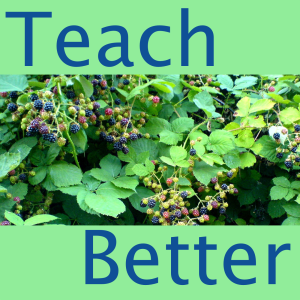
Podcast #24: Memory, Motivation, and Metacognition with Michael Honsberger
 2016-01-18
2016-01-18
In this episode we’re joined by Michael Honsberger, neuroscientist and STEM project manager for the Yale Young Global Scholars program. Michael has a background studying memory including a PhD in behavioral neuroscience and a postdoc in Yale’s Division of Molecular Psychiatry. He talks to us about how we can use knowledge of how the brain works to become better teachers.
You can subscribe to the Teach Better Podcast through your favorite podcast app or simply subscribe through iTunes if you don’t have one yet.
Show Notes0:00 ⏯ Intro
0:39 ⏯ About Michael Honsberger
4:29 ⏯ The science of memory tells us that memory is not a recording: it’s a construction.
7:11 ⏯ If memory is a construction, you need to start with the framework: Memorize the details after the framework is in place.
8:42 ⏯ Memory science’s newcomer is reconsolidation. There is no filing cabinet in the brain–The act of retrieving a memory sometimes makes the memory plastic. If we couldn’t update memories, our brains would have to grow.
13:41 ⏯ Is teaching changing beliefs? Is it harder than we imagine?
17:24 ⏯ Getting some closure on memory. Surprise is one of the more reliable ways of “destabilizing” a memory–i.e., changing what students think they already know.
20:36 ⏯ Cramming is just a lousy way to form memories. Massed practice is far less efficient than spaced practice.
23:10 ⏯ What happens when students have access to online materials? Doug’s experience: lecture capture allows mass practice–and poor exam grades.
24:57 ⏯ How do you motivate the students to do the work all along instead of cramming at the end?
25:39 ⏯ Is there a neuroscientific basis for teaching using multiple forms of representation?
26:38 ⏯ There’s not a filing cabinet: memories are not stores in one physical location.
28:10 ⏯ How we can motivate our students to study effectively; Extrinsic vs. intrinsic motivation
29:38 ⏯ Teaching psychology as skills for life–and learning. Helping college students use Bloom’s taxonomy; Memorization isn’t enough in college.
34:51 ⏯ College students can get better at metacognition: “hacking college.” Performing a quasi-experiment about metacognition.
40:54 ⏯ Michael’s students with poor metacognition over-estimated the grade they would get in the course.
42:12 ⏯ Do unrealistic students just have very poor metacognition? Not necessarily.
43:35 ⏯ How do we get buy-in from students when we want to teach them how to learn? Trust is key. The syllabus is a contract that goes both ways. Mimicry behaviors can be strategically effective.
47:27 ⏯ Emotion helps to enrich memory–e.g., personalizing information.
49:35 ⏯ What Michael does now: teaching the teachers.
53:33 ⏯ Three tips for using cognitive science in the classroom. Teaching students how to be students.
54:37 ⏯ Accepting the students and helping them with their skills. Reading for mastery vs. recreation. You must read Tolstoy’s econ textbook.
56:56 ⏯ Using the skills you’re teaching to students. Building a cognitive framework and teaching to skim.
59:32 ⏯ Listen to this podcast again in a week. College is hacking yourself.
1:01:24 ⏯ Epic teaching fail: fun but uninformative. Should teaching be serious? Or fun? Is this really a trade-off?
1:05:33 ⏯ The first day of a course is not necessarily about learning.
Want to learn more about using insights from cognitive science in your teaching? Check out these links:
How to use cognitive psychology to enhance learning (Dr. Robert Bjork on the Teaching in Higher Ed podcast)
Science of Student Ratings (a 40m presentation by Sam Moulton, Director of Educational Research and Assessment at Harvard’s Derek Bok Center)
Applying Psychological Science to Higher Education: Key Findings and Open Questions (an article by Sam Moulton)
How to get the most out of studying (a fantastic video series for students and teachers by Stephen Chew )
More Episodes
Create your
podcast in
minutes
- Full-featured podcast site
- Unlimited storage and bandwidth
- Comprehensive podcast stats
- Distribute to Apple Podcasts, Spotify, and more
- Make money with your podcast
It is Free
- Privacy Policy
- Cookie Policy
- Terms of Use
- Consent Preferences
- Copyright © 2015-2024 Podbean.com





